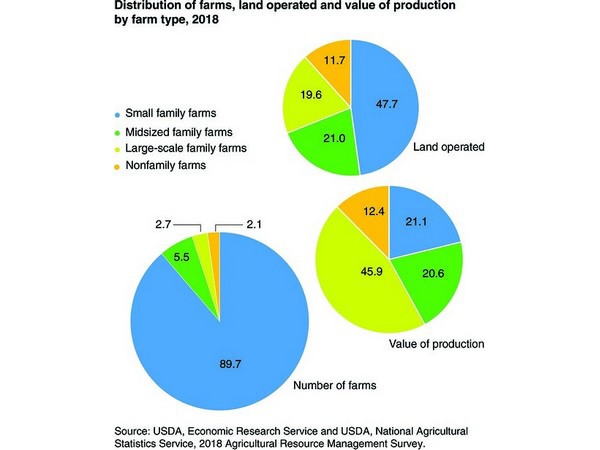The more than 2 million farms in the U.S. vary greatly in size and characteristics. For example, annual gross revenue can range from as little as $1,000 to more than $5 million.
USDA’s Economic Research Service (ERS) recently released its widely used annual report that describes characteristics of different types of U.S. farms, titled America’s Diverse Family Farms: 2019 Edition. Farms are classified based on ownership of the farm, annual gross revenue, and the primary occupation of the principal operator.

The research found that family farms remain a key part of U.S. agriculture, making up 98% of all farms and providing 88% of production. Most farms are small family farms, and they operate almost half of U.S. farm land, while generating 21% of production. Midsize and large-scale family farms account for about 66% of production; and non-family farms represent the remaining 2.1% of farms and 12% of production.
The specific commodities produced tend to vary by farm type. Small farms produce most U.S. poultry (including eggs) and hay. Midsize and large-scale farms account for most of the cotton, cash grains, and oilseed production. Large-scale farms produce the bulk of dairy. Finally, large-scale and non-family farms dominate production of beef production and high value crops which include vegetables, fruits/tree nuts, and nursery/greenhouse products.
In general, farm households are neither low-income nor low-wealth. Retirement family farms (farms where the principal operator reports being retired from farming) and low-sales farms (those with operators primarily engaged in farming and having less than $150,000 in revenue per year) are the only two farm types with median income below the median income for all U.S. households and the median income of households with self-employment income. Overall, we see that median household income increases along with farm sales.
Many family farm households combine farm and off-farm work to generate income and receive other benefits from an off-farm job. Off-farm occupation farms are those where the principal operator reports doing something other than farming as their main occupation. Over 80% of these operators work at an offsite location, as do 62% of their spouses. Principal operators of large-scale farms (those with $1 million or more in sales per year) are less likely to work off the farm compared to small and midsize farms. Where the spouses of principal operators held an off-farm job, a majority cited “health care benefits” as one reason for working off the farm.
Farming is still overwhelmingly comprised of family businesses. While most U.S. farms are small, most agricultural production occurs on large-scale and midsize family farms (farms with more than $350,000 in annual gross revenue). America’s Diverse Family Farms report reveals that families remain central to our agricultural economy.
Source: USDA (Christine Whitt)
